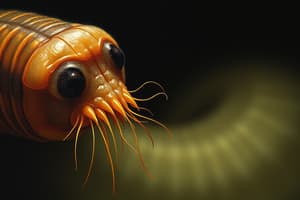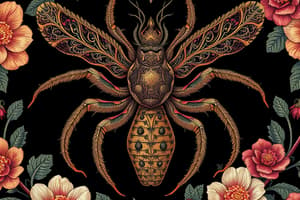Podcast
Questions and Answers
What is the characteristic of the excretory system in class Aphasmida?
What is the characteristic of the excretory system in class Aphasmida?
- It is present only in females
- It is present only in males
- It is well-developed
- It is absent or reduced (correct)
What is the function of stichocytes in Trichinella spiralis?
What is the function of stichocytes in Trichinella spiralis?
- Ion and osmotic regulation (correct)
- Secretion of enzymes for digestion
- Movement of the worm
- Cuticle formation and food storage
Where do the adult stages of Trichinella spiralis live?
Where do the adult stages of Trichinella spiralis live?
- In the bloodstream
- In the skeletal muscles
- In the intestinal wall (correct)
- In the liver
What is the result of infection by Trichinella spiralis in humans?
What is the result of infection by Trichinella spiralis in humans?
What is the characteristic of the esophagus in order Trichurida?
What is the characteristic of the esophagus in order Trichurida?
How does the human get infected with Trichinella spiralis?
How does the human get infected with Trichinella spiralis?
What is the feature of the male Trichinella spiralis?
What is the feature of the male Trichinella spiralis?
What is the characteristic of class Phasmida?
What is the characteristic of class Phasmida?
What is the characteristic of the posterior body region in order Oxyurida?
What is the characteristic of the posterior body region in order Oxyurida?
What is the ploidy of the male and female in order Oxyurida?
What is the ploidy of the male and female in order Oxyurida?
Flashcards are hidden until you start studying
Study Notes
Phylum Nematoda: Class Aphasmida
- Lacking phasmids (caudal sensory organs) and excretory system is absent or reduced
- Males have one spicule or no spicule at all
Order Trichurida
- Anterior end of the worm is more slender than the posterior end
- Esophagus has one or two rows of gland cells called stichocytes along its posterior portion
- Excretory system is absent
- Bacillary bands are present, consisting of glandular and non-glandular cells
- Glandular cells may be involved in ion and osmotic regulation
- Non-glandular cells may be involved in cuticle formation and food storage
Trichinella spiralis
- A parasite of mammals, including humans
- Immature and adult stages can be found in the same host
- Body length is 2-4mm
- Esophagus occupies ⅓ - ⅟2 of body length
- Male lacks spicule, but has a copulatory pseudobursa
- Life cycle involves ovoviviparity, with juveniles moving through blood circulation and encysting in skeletal muscles
- Humans are infected by consuming pork flesh infested with cysts
- Infection causes fever, diarrhea, and damage to blood vessels and infected organs
- Stichocytes secretion alters muscle nurse cell function, leading to nuclei hypertrophy and myofibril loss
Studying That Suits You
Use AI to generate personalized quizzes and flashcards to suit your learning preferences.




